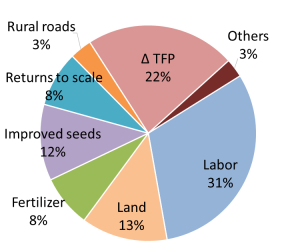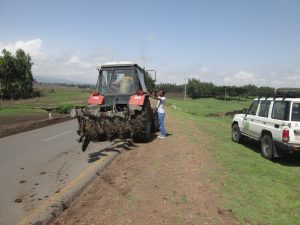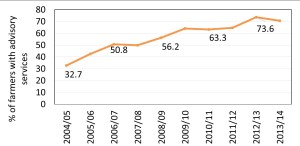On January 22nd, 2016, a short presentation on agricultural growth in Ethiopia over the last decade was delivered at EDRI by Bart Minten, the team leader at ESSP. In total, 34 people attended.
Ethiopia’s agricultural growth performance over the past decade has been the focus of in-depth research by ESSP, and has generated a lot of interest from government and donors alike. Ethiopia is one of the fastest growing economies in the world, with a large proportion of this growth being in agriculture. The primary purpose of this research was to learn lessons from the past decade and to help identify binding constraints to improve agriculture’s performance in the country.
The presentation illustrated how, where and in what areas the economy has grown, describing the factors that have contributed to the unprecedented growth. Using national data, ESSP researchers showed, for example, that area cultivated grew by 27 percent during the decade, with cereal yields increasing by 7 percent per year. Some factors contributing to this crop growth have been intensifying labor and land, using fertilizer and improved seed, better infrastructure to facilitate access and productivity among others.

Figure 1 - Contribution to crop output growth (2004/05 – 2013/14), percent
The research presented examined the drivers for change, identifying drivers based on two criteria: first, those linked with significant increases in adoption of improved practices, and second, those related to major positive changes over the last decade. One most notable change has been the considerable investment into public agriculture extension systems, with Ethiopia demonstrating one of the highest extension agent-to-farmer ratios in the world.
Figure 2 - Share of farmers covered through extension
The drivers were clearly illustrated during the presentation, demonstrating strong evidence-based investigations by ESSP’s researchers. However, there remains room for further investigation into yields across different datasets and data collection methods, cereal output growth, and land use changes. The sustainability of intensification continues to present challenges, often exacerbated by adjustments to climate change. Moreover, the link with nutritional outcomes is not to be underrated. Closely linked with nutritional and agricultural pay-offs are gender issues, where substantial change could be gained from empowering women. Finally, mechanization was described as becoming increasingly important, especially with tightening labor markets.
ESSP has released a new Working Paper (number 81) entitled “Agricultural Growth in Ethiopia (2004-2014): Evidence and Drivers”. This, along with this presentation, fills an important gap in understanding what has happened in Ethiopia’s agricultural sector in the last decade, what were the sources of growth and whether the growth observed was real or not. This research has had impact on current thinking by Ethiopia’s government, shown in their analysis and subsequent report of Ethiopia’s unique growth performance, entitled “Ethiopia’s great run: The growth acceleration and how to pace it”, published by the World Bank in 2015 (see also Outcome Note Number 12).
This presentation was organized by ESSP with support from EDRI. ESSP is a collaborative program undertaken by IFPRI and EDRI, whose objective is to help improve the policy-making decision process in Ethiopia.
You may can subscribe to receive regular updates on ESSP’s work and its quarterly newsletter.

